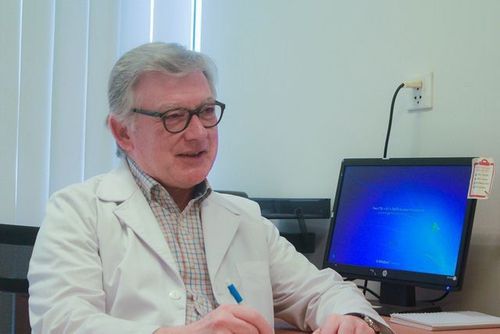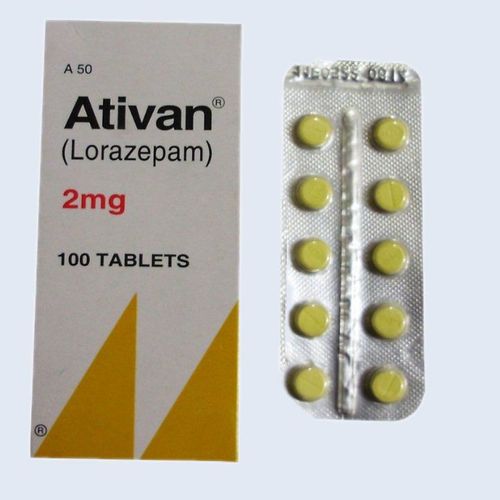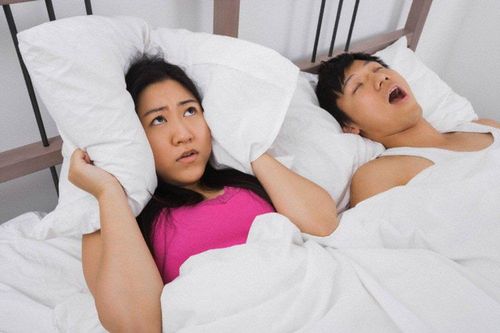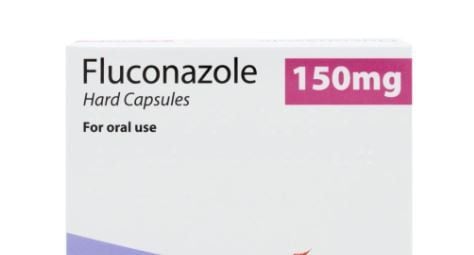This is an automatically translated article.
Snoring and sleep apnea are sleep disorders, affecting health and leaving consequences later. In order to treat and handle this condition thoroughly, many people have chosen to correct the oropharynx through surgery.
1. Snoring, sleep apnea
Characteristics and mechanism of action of the pharynx, uvula
When air is brought to the back of the pharynx, it will have to pass through a narrow passage to increase velocity before entering the trachea and lungs. This increase in velocity is due to the contraction of the diaphragm creating a negative pressure that pulls the pharynx and the soft uvula posteriorly. The process of exhaling and breathing in will create vibrations of the uvula and pharynx, creating the sound of snoring. When we open our mouth to look in the mirror, we can see the image of the pharynx and the uvula like drops of water attached.
Snoring is quite common in many people, manifesting in the fact that the patient often makes sounds from the airways during sleep. The loudness of the snoring sound varies from person to person, from time to time. Simple snoring is usually not harmful, but in more severe cases it can be a sign of sleep apnea syndrome.
At-risk population
Men have a higher risk of snoring than women. Common in adults, accounting for about 5% of the population. Older people (over 60 years old) are more likely to snore and sleep apnea due to decreased muscle tone. People with thick pharyngeal curtain, long uvula, crooked nasal septum, underdeveloped lower jaw (also known as low chin). Children with enlarged tonsils. Pregnant women (especially the last 3 months) are also prone to snoring due to increased weight.
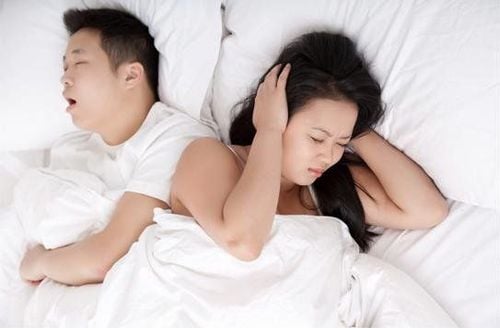
Đàn ông ngủ ngáy có nguy cơ mắc bệnh cao hơn phụ nữ
2. Treatment direction of uvula
Treatment of snoring, sleep apnea includes many different methods: Through exercise, nutrition, and reasonable weight loss; change sleeping position to lying on your side; taking decongestants (vasoconstrictors) to treat nasal congestion; anti-allergic antihistamines; Wear a plastic jaw while sleeping and breathe CPAP (continuous positive pressure). Finally, if the case is serious and requires definitive treatment, the doctor may suggest the patient to perform orthopharyngeal surgery as follows:
2.1. Standard surgery Previously, surgery of the uvula and pharynx mostly removed the uvula, pharynx, including tonsils, to make the pharynx area more open. However, the current classical surgery is rarely used because it causes a lot of pain after performing, can cause opening of the pharynx, making the patient easy to choke on the nose when eating, long-lasting throat sensory disturbance... Today With advanced technology, many patients choose a more improved method of orthopharyngeal oropharyngeal orthodontics. The advantage of this method is that it only minimally interferes with the pharyngeal membrane, the procedure is less painful and has fewer sequelae. In children, tonsillectomy and VA curettage are considered first-line measures to treat snoring and sleep apnea.
2.2. Laser surgery is a form of correction of the uvula with a CO2 laser. Mainly used to treat patients with simple snoring, without sleep apnea. This type of surgery is less painful and has fewer complications.
2.3. Radiofrequency surgery This is a method of using high-frequency waves to make the pharynx fibrosis. The advantage is that the technique is simple, causes little pain, can be performed under anesthesia, and is performed as many times as needed.
2.4. Implantation of the pharyngeal curtain is a technique of inserting 3 special plastic pillars under the pharyngeal muscle to support the pharynx, thereby reducing the vibration of the pharynx, reducing snoring. However, the disadvantage is that the efficiency is average and the cost is high.
3. Standard uvula orthodontic procedure
The goal of surgery is to widen breathing space in the pharynx and mouth by removing excess soft tissue from the pharynx and lateral wall of the pharynx (possibly removing tonsils). This surgery can use laser to scar the pharynx to help reduce vibration of the pharynx, reducing snoring.3.1. Indications and contraindications Indications case
Patient suffers from snoring. The patient has obstructive airways syndrome.
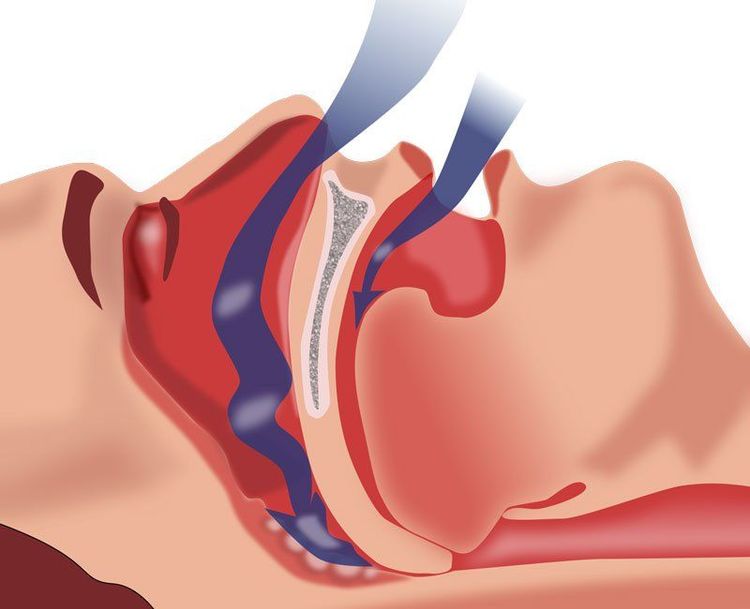
Người mắc hội chứng tắc nghẽn đường thở cần được chỉnh hình màn hầu lưỡi gà
Contraindications
Cleft palate. The case of the pharynx is not the cause of the obstruction. Blood clotting disorder. Chronic lung disease. 3.2. Before surgery, patients and families need to know some information as follows:
Implementation team: Including a trained Ear-Nose-Throat specialist. create specialist surgery and assistants (if needed). Surgical facilities and equipment: Including head and neck surgical instruments; electric knife, single - bipolar electric freezer; CO2 laser kit and handle (if any). Preparation: The patient and family should keep a comfortable mind, listen to the pre-operative explanation about the orthopharyngeal retropharyngeal procedure. Especially before surgery, patients need to perform basic tests to allow surgery; ear-nose-throat, maxillofacial examination. 3.3. Surgical procedure Preparation: The patient is asked to lie in a supine position with the head supine as in tonsillectomy. The doctor anesthetizes the patient with general anesthesia.
Step 1: Use a Davis mouth opener to expose the pharynx and pharynx.
Step 2: Pull the uvula forward and up, proceed to cut the mucosa starting from the midline, to the top of the uvula, across to the outside and then down to the bottom of the tongue.
Step 3: After cutting the mucosa on the inside of the mouth, cut to the uvula muscle. Note: the posterior mucosa is cut slightly lower to form a mucosal flap, which can be rotated and sutured to cover the pharyngeal muscle. Resection of the excess mucosa on the lateral pharynx in the posterior column of the tonsils, together with the mucosa of the pharynx.
Step 4: Hemostasis and recovery stitches, stitches attached to pharynx - pharyngeal membrane and tongue - pharyngeal curtain together.
3.4. Monitoring and handling complications Similar to any other surgery, although not complicated, buttoplasty uvula surgery can also have potential risks such as:
Bleeding at the incision site Infection of the surgical site If you see abnormal signs after surgery, the patient should immediately notify the doctor for timely treatment and care. For faster recovery, patients may be suggested to take broad-spectrum antibiotics, anti-inflammatory, anti-edematous, pain relievers. Special attention should be paid to proper hygiene of the throat and mouth; Eat soft and cool for at least 10 days.
Please dial HOTLINE for more information or register for an appointment HERE. Download MyVinmec app to make appointments faster and to manage your bookings easily.





